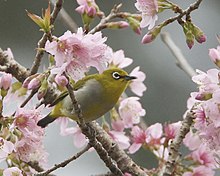Prunus cerasoides, commonly known as pahhiya (पैयाँ),[4] the wild Himalayan cherry or sour cherry[5] is a species of deciduous cherry tree in the family Rosaceae.
| Prunus cerasoides | |
|---|---|

| |
| Indian white-eye in a wild Himalayan cherry | |
| Scientific classification | |
| Kingdom: | Plantae |
| Clade: | Tracheophytes |
| Clade: | Angiosperms |
| Clade: | Eudicots |
| Clade: | Rosids |
| Order: | Rosales |
| Family: | Rosaceae |
| Genus: | Prunus |
| Subgenus: | Prunus subg. Cerasus |
| Species: | P. cerasoides
|
| Binomial name | |
| Prunus cerasoides | |
| Synonyms[3] | |
|
List
| |
Its range extends in the Himalayas from Himachal Pradesh in north-central India, to south-western China, Burma and Thailand. In India the tree is widely revered in the Himalayan State of Uttarakhand. The tree is found in temperate forest from 1,200–2,400 metres (3,900–7,900 ft) in elevation.[6]
Description edit
Prunus cerasoides is a tree which grows up to 30 metres (98 ft) in height. It has glossy, ringed bark. When the tree is not in flower, it is characterised by glossy, ringed bark and long, dentate stipules.[citation needed]
The tree flowers twice a year, during autumn and spring. First flowering blooms between the months of January to April and second flowering blooms between September to November.[7] Flowers are hermaphroditic and are pinkish white in color. It has ovoid yellow fruit that turns red as it ripens.[citation needed]
Cultivation edit
Prunus cerasoides thrives in well-drained and moisture-retentive loamy soil, in an open, sunny, and sheltered location.[citation needed]
P. cerasoides, like most members of the genus Prunus, is shallow rooted and is likely to produce suckers if the root is damaged. It is likely to become chlorotic if too much lime is present. It is known to be susceptible to honey fungus.[citation needed]
The seed requires two to three months cold stratification and is best sown in a cold frame as early in winter as possible. The seed grows rather slowly and can sometimes take about 18 months to germinate depending on the conditions.[citation needed]
Religious Significance In Uttarakhand edit
The tree is referred to as “पंय्यां” in the Himalayan State of Uttarakhand, India and is regarded as a holy tree by various groups in both the Garhwal and Kumaon region. Cerasoides is among the few trees in the region that remain blooming at the height of winters during, December and January. The tree is also never chopped down in the region.[4]
is regarded as a or a tree of the gods in Uttarakhand and is thus treated with much reverence. Village weddings have pahiya branches placed intentionally at the entrance. And the wedding mandap is also considered incomplete without having been decorated with the branches and leaves from the tree.[4]
Acharya Manu notes that 'Padma' is the tree of God. Which remains happy even in the adverse weather. When all the trees drop their leaves during the harsh winter season, flowers grow in the leaves of the tree. The use of its wood in the wedding hall symbolizes strength and happiness in the new life of the bride and groom.[4]
Its stalk is also used one way or another in Yajnopaveet, Jagar and Baisi. Among the instruments played in religious programs, Lukudi made of wood of Paiyan tree is considered to be the most sacred. Apart from this, the garlands used in homes during the house warming yajns, yagyopaveet etc. are also made from paiyan leaves. [4]
In Hindi the tree is known as Padma, Padmakh or Padmakashtha, in Sanskrit it is known as Charu, Hima, Kaidra, Malaya, Padmagandi and in Nepali it is known as Paiyu.
Uses edit
Food edit
- Fruit — 15mm in diameter, the fruit can be eaten raw or cooked.
- Gum — Gum is chewed and obtained from the trunk. It can be employed as a substitute for gum tragacanth.
- Seed — It can be eaten raw or cooked.
Other uses edit
The fruits and the leaves give a dark green dye. Seeds can be used in the manufacture of necklaces.
The wood is hard, strong, durable and aromatic, and branches are used as walking sticks.
References edit
- ^ Rhodes, L.; Pollard, R.P.; Maxted, N. (2016). "Cerasus cerasoides". IUCN Red List of Threatened Species. 2016: e.T50026860A50670270. doi:10.2305/IUCN.UK.2016-3.RLTS.T50026860A50670270.en. Retrieved 9 February 2023.
- ^ "Plant Name Details for Prunus cerasoides D.Don". IPNI. Retrieved September 16, 2009.
- ^ See Taxonbar
- ^ a b c d e Tree, Kafal (2020-12-23). "पैयाँ की टहनियों बिना पहाड़ियों की शादी का मंडप अधूरा रहता है". Kafal Tree. Retrieved 2024-01-31.
- ^ "Prunus cerasoides". Germplasm Resources Information Network. Agricultural Research Service, United States Department of Agriculture. Retrieved January 24, 2014.
- ^ Chandel, V.; Rana, T.; Hallan, V.; Zaidi, A. A. (2007). "Wild Himalayan Cherry (Prunus cerasoides) as a Natural Host of Prunus necrotic ringspot virus in India". Plant Disease. 91 (12): 1686. doi:10.1094/PDIS-91-12-1686C. PMID 30780621.
- ^ Kurniawan, V (16 May 2021). "Phenology and morphological flower of Prunus cerasoides Buch.-Ham. Ex D. Don". IOP Conference Series: Earth and Environmental Science. 948 (1): 8. Bibcode:2021E&ES..948a2047K. doi:10.1088/1755-1315/948/1/012047. S2CID 245259406. Retrieved 16 May 2021.
